According to the Biden Administration, a main feature of its “Families Plan” would be “tax cuts for America’s families and workers,” asserting its plan would offer “key tax cuts…that benefit lower- and middle-income workers and families.”REF
In reality, the Biden “child allowance” plan would offer no long-term tax relief to families with children. Even in the short term, some 74 percent of aid would go for cash grants to families who owe no income tax; only 26 percent would go for tax relief. But even this limited tax relief would be temporary: The plan’s permanent provisions, in fact, would provide zero tax relief to families with children. All permanent assistance would be restricted to cash grants for families without tax liability.
Moreover, contrary to most press coverage, the proposed Biden legislation would not permanently raise the per-child yearly benefit from $2,000 to $3,000. That change would also be temporary. Under the plan, the sole permanent change in the law would be to eliminate all work requirements and work incentives from the current child credit program. The primary goal of this policy would be to restore, for the first time in a quarter century, unconditional federal cash welfare grants to families who choose not to work during the year. This cash aid would not be time limited, but would be offered every year until a child turned 18.
Most of the permanent aid under the plan would be focused on families who do not work or work comparatively little. The plan would also disproportionately assist non-married, rather than married, families. About one-quarter of all children live in non-married families, but under the plan, nearly 60 percent of new permanent assistance would go to those families.
History of the Child Tax Credit
When the Child Tax Credit was originally created in 1997, it provided pure tax relief.REF Parents could claim a $500 per-child credit in tax reduction. Families that owed no income taxes could not claim the credit.
In 2000, the child credit was modified to provide cash grants as well as tax relief.REF The modified credit had three main provisions:
- A maximum credit of $1,000 per child.
- A work requirement for cash grants: Families had to have employment with minimum annual earnings to receive any cash grant.
- A pro-work benefit phase-in for cash grants; in order to encourage work, the value of cash grants was increased as annual earnings increased.REF (This benefit phase-in structure also created pro-marriage incentives—whenever an employed partner married a care-giving partner who was not employed or worked only a little during the year.)REF
These three parameters have served as the foundation of the child credit/cash grant system for the past 20 years. The most recent long-term provisions of the child credit were established in the Tax Cuts and Jobs Act (TCJA), signed into law in December 2017.
The TCJA provided:
- A maximum tax reduction credit of $2,000 per child;
- A minimum work requirement of at least $2,500 in annual earnings to receive any cash grant; and
- A work-linked benefit phase-up in which the cash grants are equal to 15 percent of earnings, up a maximum of $1,400 in cash per child.REF
Although some families may receive both cash grants and tax relief, the maximum value of cash grants and tax reduction combined may not exceed $2,000 per child. As a family’s income rises, its pre-credit tax liability will also rise, and a greater share of the $2,000 per-child maximum will go to tax relief rather than cash grants. At a certain income level, the entire $2,000 per child will go to tax reduction.
Chart 1 demonstrates the operation of the TCJA system for a single-parent family with two school-age children.REF The chart shows the general pattern of the program: To incentivize work, cash grants (shown in yellow) are increased as earnings rise. After earnings reach around $19,000, the family begins to face positive income tax liability and the credit provides increasing tax relief (shown in blue) to reduce that tax burden to zero.
The combined value of the cash grants and tax relief for two children cannot exceed $4,000; as income rises, the share of the combined support going to tax relief increases, and the share going to cash grants shrinks. When family income reaches $54,400, all of the $4,000 (for two children) goes to tax relief. Families with two children continue to receive $4,000 in reduced taxes until income reaches $200,000. At that point, the tax relief is incrementally reduced to zero by $280,000, a 5 percent phase-out rate. (This phase-down is not shown on the chart.)
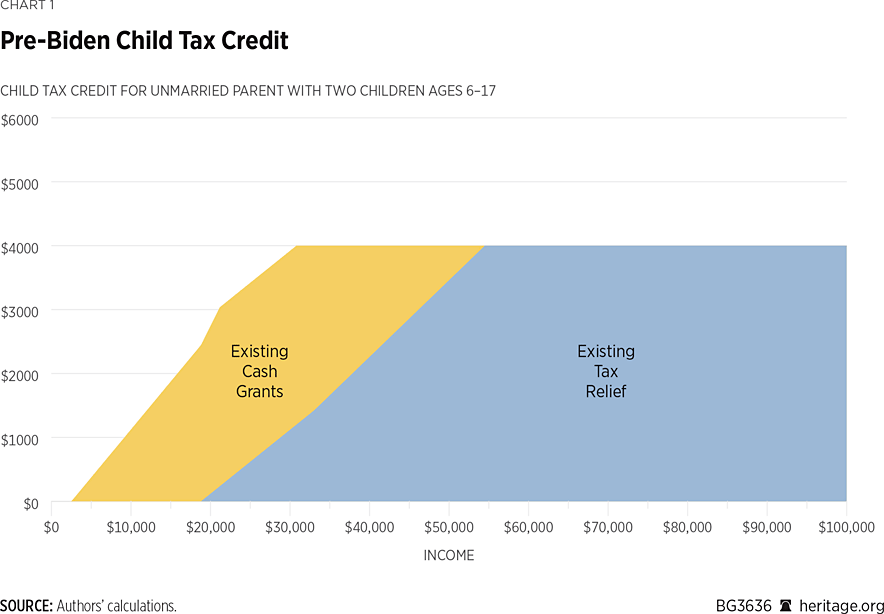
The three provisions from the TCJA shown in Chart 1 were binding from 2018 to 2020. In March 2021, the Biden Administration passed a “COVID relief” package called the American Rescue Plan, which altered child credits in a manner described below. However, the provisions of the American Rescue plan were purely temporary; they pertained only to the year 2021. Under current law, the TCJA provisions (described above and shown in Chart 1) will resume automatically in 2022 if the proposed Biden American Families Plan is not enacted.
The Biden Cash Grant/Child Allowance Plan (Temporary Stage 1)
Biden’s American Families plan would make three fundamental changes to the existing child tax credit/cash grant system.REF The plan would raise the per-child value of the cash grants/child tax credit while removing all links and incentives for work and marriage within the program.
Specifically, the plan would:
- Raise the value of the cash grants and tax relief from $2,000 per child to $3,000 for each child 6–17 years old and $3,600 for each child under 6 years old;
- Eliminate the requirement that a family earn at least $2,500 per year to be eligible for benefits: A family would receive the full value of the credit as a cash grant without any work; and
- Remove the entire pro-work, pro-marriage incentive structure of the traditional child credit, which incrementally raises benefits as earnings rise.
As a result, the proposed Biden credit would have a flat value of $3,000 per school-age child whether or not the family works. (Like the current credit, the proposed credit would phase down at higher incomes, but this phase-down would occur at significantly lower earnings levels than current law.)REF
The impact of the Biden plan for a single-parent family with two school-age children is shown in Chart 2.REF Cash grants under existing law are shown in yellow, tax relief under existing law in light blue. The proposed increased cash grants are shown in red. New tax relief generated by the plan is shown in darker blue.
By far, the greatest increase in benefits goes to families that do not work at all or work comparatively little. Families with a full-time worker (earning more than $16,000 per year) receive considerably less under the plan.
Raising the maximum value of the credit to $3,000 per child does provide some tax relief to middle-income families. This is shown in darker blue on the chart.REF
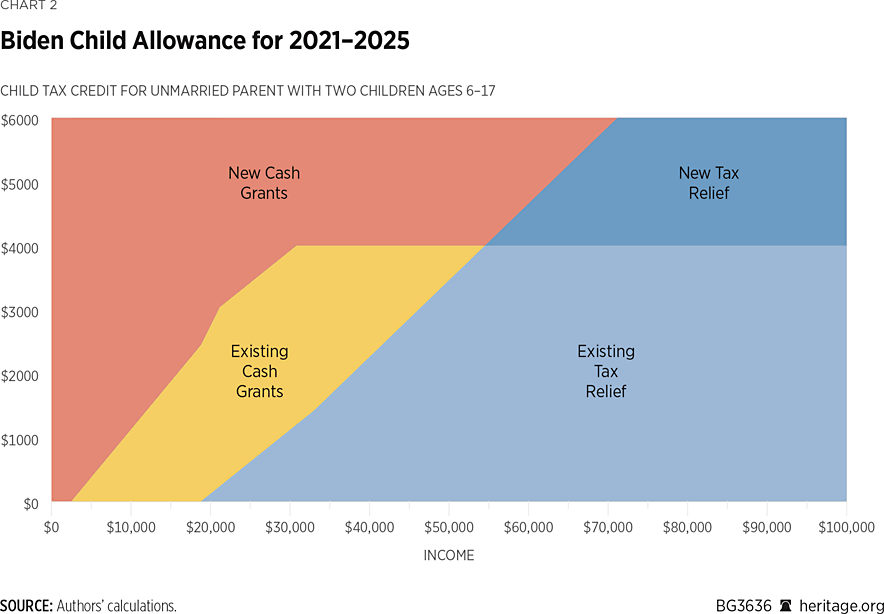
The Biden Cash Grant/Child Allowance Plan (Permanent Stage 2)
However, under the Biden proposal not all the policy impacts shown in Chart 2 would be permanent.
In fact, in the Biden proposal, only the provisions removing the work requirements and work incentives would be permanent; other changes would be temporary. Specifically, the plan would permanently eliminate the requirement that a family earn at least $2,500 per year to be eligible for benefits. It would also permanently erase the phase-in structure that links increased benefits to increased earnings.
As a permanent policy, all families would receive the maximum benefit per child, irrespective of work performed. However, the increase in the per-child maximum benefit from $2,000 to $3,000 or $3,600 per child would be temporary, lasting only from 2021 through 2025.REF As Biden’s American Families Plan proposal explicitly states, “The American Families Plan will make permanent the full refundability of the Child Tax Credit, while extending the other expansions of the Child Tax Credit through 2025.”REF The Administration’s intention to terminate the boost in the child maximum credit from $2,000 to $3,000 or $3,600 after 2025 is also documented in the President’s formal budget proposal presented in late May.REF
Because the increase in the per-child maximum benefit provides all of the added tax relief offered in the plan, eliminating this feature after 2025 ensures that the plan offers zero long-term tax relief to families with children. This is illustrated in Chart 3, which shows the impact of the Biden plan from 2026 through 2031. Again, the chart shows a single-parent family with two school-age children. Cash grants under the provisions prevailing in 2020 law are again shown in yellow; tax relief under existing law is shown in light blue. Substantial new cash grants to families who do not work, or work comparatively little, are shown in brown.
As the chart demonstrates, all the new tax relief (shown in darker blue in Chart 2) would be contingent on raising the per-child credit from $2,000 to $3,000 or $3,600. But the Biden plan would deliberately terminate this feature after 2025. This means that not a single working-class family with children would receive additional long-term tax relief under the Biden child allowance plan.
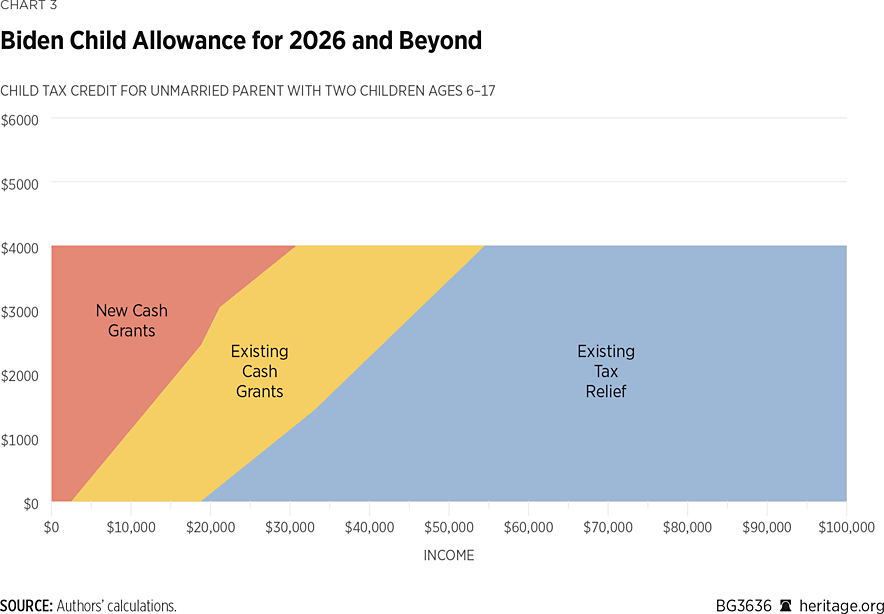
Bait and Switch
The Biden “child allowance” plan is a classic “bait and switch” maneuver.REF While the Administration advertises its policy as “tax relief” for the middle class, in fact, it offers no long-term tax relief for the middle or working class. Instead, the predominant focus of the plan is eliminating or weakening work requirements within the welfare system. The anti-work features of the plan are designed to be locked into law as permanent; any tax relief, by contrast, would be transitory.
The child allowance is a Trojan horse in which the illusion of tax relief is used to mask the real objective of reversing the work-based focus of welfare reform in the 1990s and restoring unconditional cash aid to non-working families.
Comparing the Two Stages of the Plan
The proposed plan would provide substantially greater aggregate benefits under the first stage (2021–2025) than under the second (2026–2030). In the first stage, aggregate new benefits would equal around $106 billion per annum. Some 74 percent of these benefits (or $78 billion per year) would be cash grants; 26 percent would be tax relief to middle- and working-class families. The combined five-year cost in stage 1 would be $528.9 billion.
Under the second stage (2026–2031), aggregate benefits would fall to around $27 billion. All benefits would be cash grants targeted primarily to families earning less than $20,000 per year. The combined five-year cost in the second stage would be $134.3 billion.REF
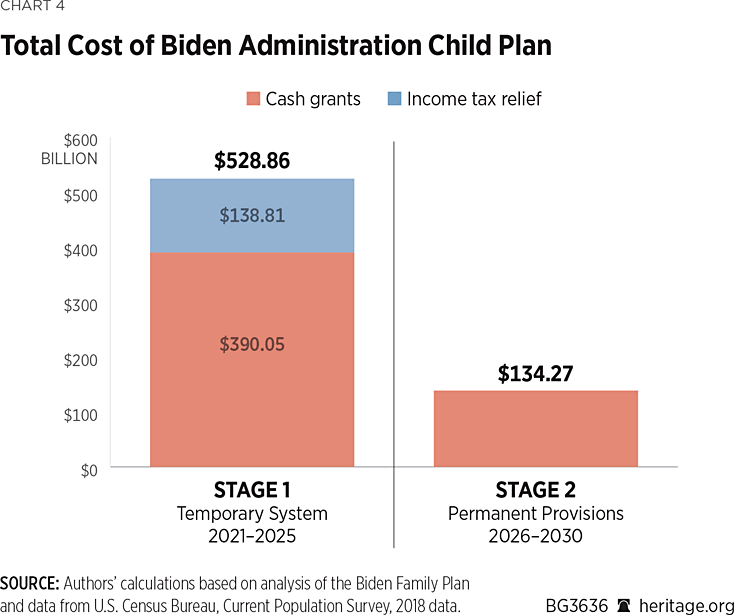
Not Middle-Class Tax Relief
Although the Biden Plan is touted as middle-class tax relief, in fact its benefits are focused on families that do not work. In 2018 there were around 2.7 million families with children who earned less than $2,500 that year and were, therefore, ineligible for the current child cash grants.REF Two million of this group were single-parent families.
Chart 5 compares the new benefits that would be received under the Biden plan by a working, married family with a median income with a single-parent family that performs no work at all during the year.
During the first stage of the plan, from 2021 to 2025, the average annual benefits to a married couple with two school-age children at the median income for such families would be $2,587. Some 94 percent of the gain would be tax reduction, allowing the hardworking couple to keep more of the money it earned rather than turn it over to the government. By contrast, the average annual benefit gain for a single parent with two school-age children who performed no work during the year would be $6,005; some 97 percent of the benefit gain would be welfare cash grants funded by general taxpayers.
The contrast would be even more striking during the second stage of the plan from 2026 to 2030. During that period, the median-income married couple would receive on average only $50 per year in added benefits, while the non-working single parent would still get new welfare cash aid of $3,582 per year.
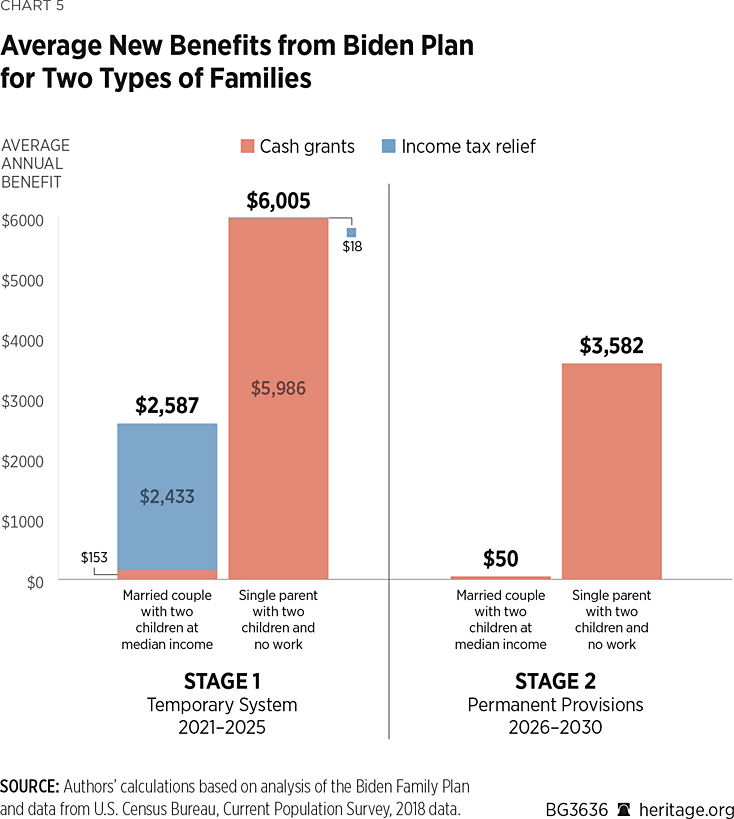
Married Versus Non-Married Families
Overall, the Biden plan would disproportionately benefit non-married, single-parent families compared to married families. Non-married, single-parent families have some 27 percent of children in the U.S. But those families would receive nearly 60 percent of the permanent new benefits provided under the plan.
In the second stage of the plan, more than half the children in non-married families would continue to be eligible for at least some cash benefit. By contrast, almost one in five children in married-couple families would be eligible.
Subsidizing Non-Work
The Biden plan is designed to focus subsidies on families that do not work at all or work comparatively little. Families with a full-time worker would receive far less under the plan. This pattern can be seen in Chart 6.
During the first stage of the plan, the average yearly per-child benefit for families with no work would be $2,966 per child. This is nearly two-and-one-half times greater than the average benefit of $1,295 that would go to families with full-time work (2,000 hours per year). In the second stage the contrast is even more extreme; the average per-child benefit for a family without work ($1,775) would be eight times greater than the benefit going to a family with a full-time worker ($218). Of course, families without work would also receive extensive benefits from other government programs such as Medicaid, food stamps, subsidized housing, Temporary Assistance to Needy Families, and Unemployment Insurance.
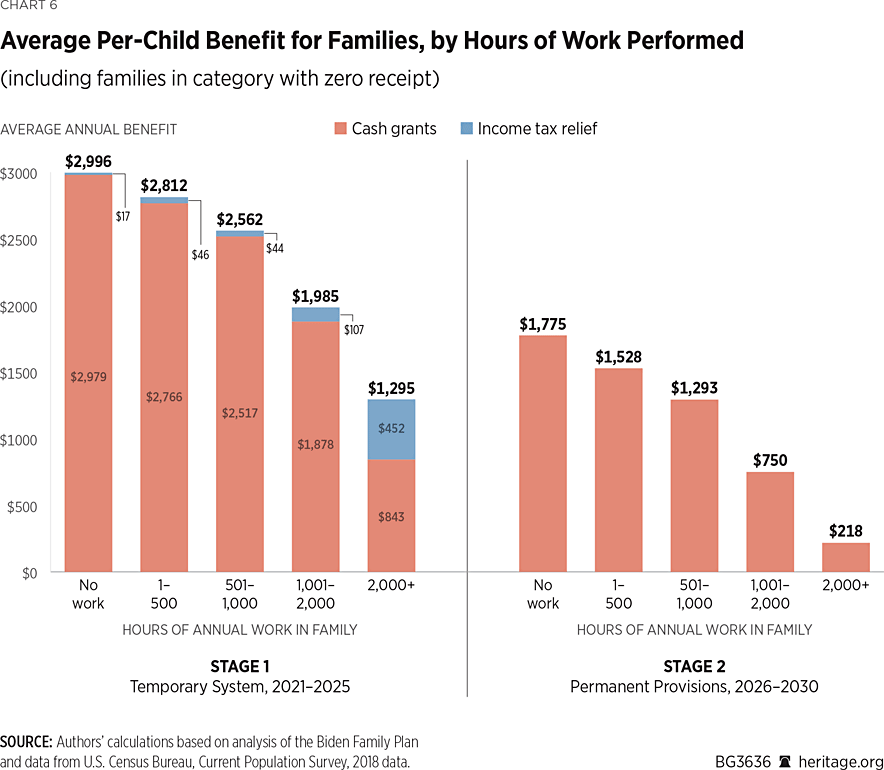
Overturning Welfare Reform
As noted, the Biden “child allowance plan” is a classic “bait and switch” maneuver.REF While the administration advertises its policy as “tax relief,” in fact, it offers no long-term tax relief for the middle or working class. Instead, the predominant focus of the plan is eliminating or weakening work requirements within the welfare system. The anti-work features of the plan are designed to be locked into law permanently; any tax relief, by contrast, would be transitory.
The Biden child allowance is a Trojan horse in which the illusion of tax relief is used to mask the real objective: reversing the work-based focus of welfare reform in the 1990s. With the work requirements permanently stripped from the law, the Biden plan overturns the fundamental principles of work-based welfare reform from the Clinton era and restores the foundation of the pre-reform welfare system: unconditional cash grants to families that do not work. This change can easily become a prelude to a full system of “guaranteed income,” in which every able-bodied person will be entitled to a cash income from the state whether they choose to work or not.
The Legacy of Welfare Reform
Overturning welfare reform would be a great mistake. The record of success under reform has been dramatic. In 1992, President Bill Clinton was elected on the pledge to “end welfare as we know it.” At that time, the welfare state was clearly failing: One of every seven children in the U.S. was dependent on the Aid to Families with Dependent Children (AFDC) program. Work among recipients was very low, and two-thirds of families receiving AFDC benefits were on the system for 12 years or more. Unwed childbearing had been skyrocketing for decades.
Within a few years, welfare reform was enacted with work requirements as its centerpiece. For the first time, recipients of cash aid were required to work or prepare for work as a condition of receiving benefits. In response, the welfare caseload experienced its first significant decline in a half-century. Within a few years, dependence had plummeted by 60 percent relative to its pre-reform levels.REF At the same time, employment of less-skilled single parents surged.REF
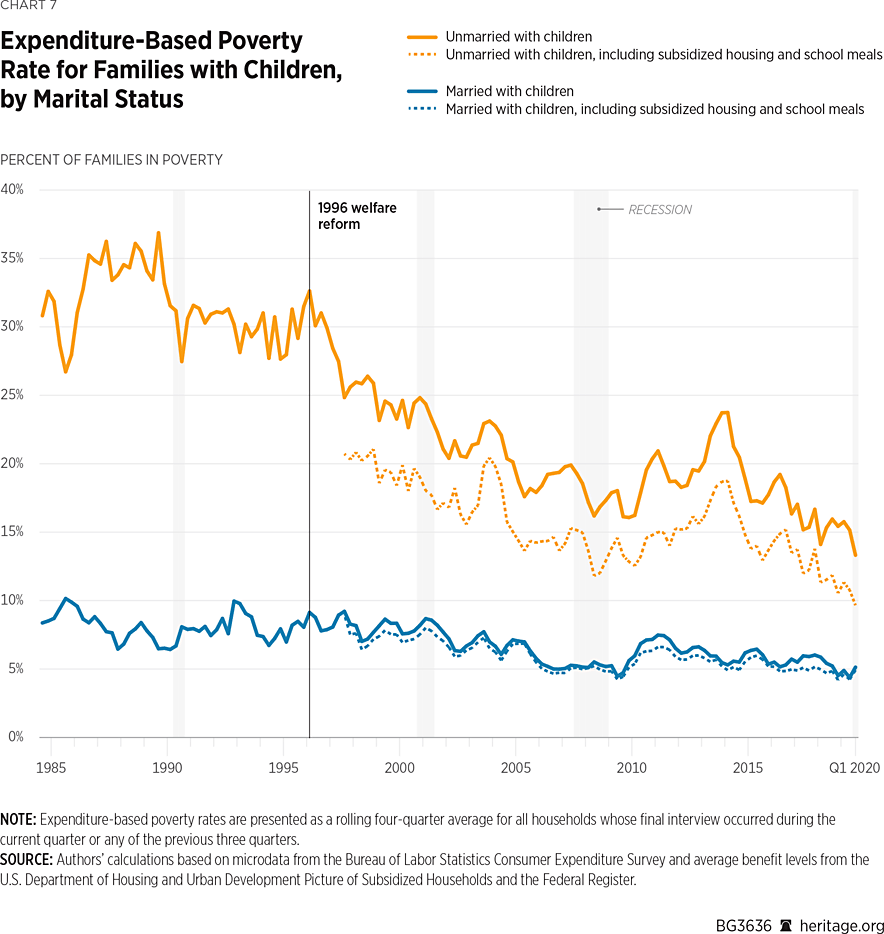
Child poverty, which had been static for decades, fell at an unprecedented rate, especially among black children.REF Other programs such as the Earned Income Tax Credit and the Child Credit built on the reform principle of requiring and incentivizing work for able-bodied recipients of aid. In the quarter-century since welfare reform was enacted, the poverty rate of non-married single-parent families has dropped by two-thirds, from around 30 percent before reform to around 10 percent in 2019.REF
The success of welfare reform was not limited to work and poverty. As Chart 8 shows, for three decades before welfare reform, the birth rate of non-married teens and young adults had risen consistently nearly every year. By the early 1990s, the rate was three times higher than the rate at the beginning of the War on Poverty in the early 1960s.
With the onset of welfare reform, this increase stopped abruptly—and a steady decline began that has persisted for a quarter-century.REF Today, all the increase in the non-marital teen and young adult birth rate that occurred in the pre-reform period has been reversed, and the rates are back to the levels from the early 1960s.REF (Abortion rates for this group fell by a similar amount.REF)
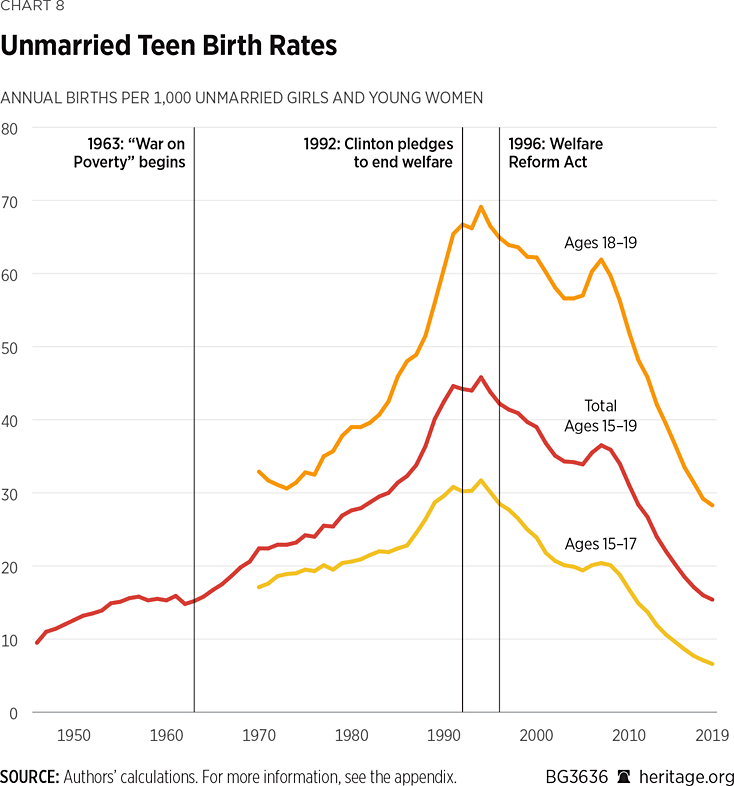
Restoring “Welfare as We Knew It”
Attaching a work obligation to welfare benefits, as welfare reform did, fundamentally changes the nature of welfare. A recipient no longer faces a choice between labor and leisure (broadly defined). Instead, the recipient faces a choice between two types of labor: employment or work-like activities mandated by the welfare agency. By removing the ability of recipients to receive recurring welfare payments without effort, a work requirement greatly reduces the attractiveness of welfare dependence relative to employment. The work requirement thereby reduces dependence and increases self-support through employment or greater reliance on relatives and parental partners.
The principle of work requirements in welfare is based on common sense—and has nearly universal public support. The public supports aid to those who need it, but they do not want welfare to be a one-way handout. The key is reciprocity: If aid is given to able-bodied individuals, they should be required to take positive steps toward self-support in exchange for the assistance given. Polls show that close to 90 percent of Americans agree that “able-bodied adults that receive cash, food, housing, and medical assistance should be required to work or prepare for work as a condition of receiving those government benefits.”REF
But the radical Left never accepted work requirements or welfare reform; instead, it has consistently sought to reverse reform by eliminating welfare work requirements and maintaining or restoring unconditional welfare aid to non-working persons and families. The Left’s goal has been, as Representative Alexandria Ocasio-Cortez (D–NY) recently put it, to provide “security for all who are…unwilling to work.”REF
Despite the fact that then-Senator Biden supported and voted for the welfare reform law in the 1990s, President Biden has now switched his position and promotes reform reversal. The Biden Family Plan seeks to overturn the principles of welfare reform by eliminating work requirements and incentives in one of the largest cash welfare programs, the child credit. If enacted, the Biden plan would go a long way toward restoring the worst features of “welfare as we knew it.”
Conclusion
The “child allowance” in Biden’s American Families Plan is a classic bait-and-switch maneuver. The main purpose of the proposal is not to provide tax relief to the working class. Any tax relief offered will be limited and transitory. In fact, when fully implemented, the plan offers no tax relief at all.
Instead, the essential impetus is to fully and permanently eliminate work requirements and work incentives from the existing child tax credit program. With the work requirements permanently stripped from the law, the plan creates a completely new system of unconditional cash grants for families that choose not to work during the year.
In making this permanent anti-work change, the Biden plan overturns the fundamental principles of work-based welfare reform from the Clinton era. That reform was rooted in the concept that welfare should not be a one-way handout: Instead, welfare assistance should be based on reciprocal obligation. Society should support those who need assistance, but able-bodied recipients of aid should in turn be required to work or at least prepare for work in exchange for the aid given.
The Biden plan restores the foundation of the pre-reform welfare system: unconditional cash grants to those who do not work. The idea of mutual obligation is abandoned and replaced by unilateral entitlement. In the future, obligations would be unidirectional: Taxpayers would be required to pay large sums to support welfare recipients, but recipients would have no obligations in return.
Welfare reform was also based on an understanding that paying able-bodied people not to work was not good for either society or recipients. It tends to push individuals out of the labor force and toward the margins of society, impeding full social participation and upward mobility for both adults and children. The Biden Family Plan rejects this understanding and does further damage by intensifying the marriage penalties within the welfare state.REF Biden seeks to resurrect the worst aspects of the old, pre-reform welfare system. This would be harmful to the poor, to taxpayers, and to society in general.
Robert Rector is Senior Research Fellow in Domestic Policy Studies, of the Institute for Family, Community, and Opportunity, at The Heritage Foundation. Jamie Hall is Research Fellow, Quantitative Analysis, in Domestic Policy Studies.
Appendix: Sources of Birth Rate Data
- National Vital Statistics, “Births: Final Data for 2019,” NVSS Report, Vol. 70, No. 2 (March 23, 2021), https://www.cdc.gov/nchs/data/nvsr/nvsr70/nvsr70-02-508.pdf (accessed July 8, 2021). This document contains data after 2014. Table 10 has birth rate data for unmarried persons from 2010–2019.
- National Vital Statistics, “Births: Final Data for 2014,” NVSS Report, Vol. 64, No. 1 (January 15, 2015), https://www.cdc.gov/nchs/data/nvsr/nvsr64/nvsr64_01.pdf (accessed July 8, 2021). Table 16 of this document contains data from 1980–2014.
- National Vital Statistics, “Births: Final Data for 2013,” NVSS Report, Vol. 64, No. 1 (January 15, 2015), https://www.cdc.gov/nchs/data/nvsr/nvsr64/nvsr64_01.pdf (accessed July 8, 2021). Table 16 gives data on unmarried birth rates from 1970–2013 by age group.
- U.S. Department of Health and Human Services, Vital Statistics of the United States: 1979, Public Health Service, National Center for Health Statistics, Vol. 1–Natality, 1984, https://www.cdc.gov/nchs/data/vsus/nat79_1.pdf (accessed July 8, 2021). Table 1–32 has data from 1970–1980.
- U.S. Department of Health, Education, and Welfare, Vital Statistics of the United States, 1970, Public Health Service, National Center for Health Statistics, Vol. 1–Natality, 1975, https://www.cdc.gov/nchs/data/vsus/nat70_1acc.pdf (accessed July 8, 2021). Table 1–30 has yearly data from 1945–1970.



